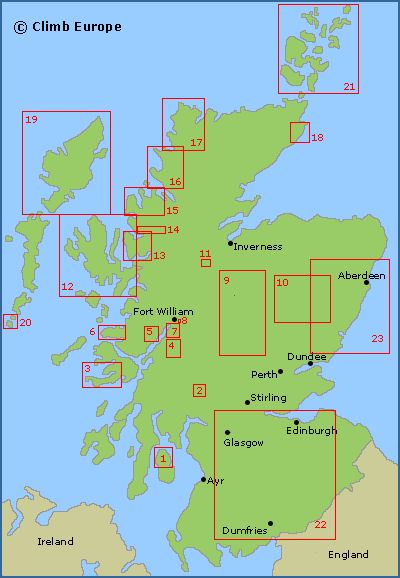Rock climbing in Scotland
With its mountain landscapes, deep glens, lochs, rivers and hundreds of islands, there is a great wealth and diversity of rock climbing to be found in Scotland. This ranges from huge mountain crags, sea cliff climbing to smaller outcrops, sport climbing venues and bouldering. Scotland offers more though with its magnificent scenery, the wide open spaces and the possibility of solitude. Often, by choosing your venue carefully, it is possible to have the whole crag to yourself, or even the whole mountain.
(1) – Arran. Traditional rock climbing on granite cliffs with routes up to 300m long.
(2) – Arrochar Area. The Arrochar Alps offer a wide range of single pitch and multi-pitch routes.
(3) – Mull & Iona. Here there are numerous single pitch crags located near the coast
(4) – Glen Coe & Glen Etive. Traditional rock climbing on Rhyolite and Andesite rock, with routes from 15m outcrops close to the road, to longer mountaineering style climbs up to 300m long.
(5) – Ardgour. Good isolated climbing away from the crowds.
(6) – Ardnamurchan. Good isolated climbing away from the crowds.
(7) – Glen Nevis. One of the best outcrop venues in Scotland, with over 70 mainly south facing crags.
(8) – Ben Nevis. Ben Nevis is Scotland’s highest mountain and its northern face drops vertically for over 600m. It is best known as a winter climbing destination, though it also offers excellent traditional rock climbing on Rhyolite rock, with routes up to 500m long.
(9) – Central Highlands. This is a vast area with numerous crags, both short and long on schist or granite rock.
Map of the main rock climbing areas in Scotland

10) – Cairngorms. The Cairngorms provide some of the best mountain rock climbing available in Scotland. Here the routes vary from 100m to 300m long on good quality granite rock.
(11) – Easter Ross.
(12) – Isle of Skye. Skye has two contrasting styles of rock climbing, with long multi-pitch rock climbing on the Cuillin mountain range as well as some excellent sea cliff climbing.
(13) – Applecross.
(14) – Torridon. The rock at Torridon is either excellent quartzite or sandstone, with routes ranging between 100m and 200m in height.
(15) – Gairloch and Ullapool. This sparsely populated area of Scotland has many trad routes in the spectacular mountains to the south of Ullapool. Here there is also a surprising number of sport climbing venues as well.
(16) – Coigant and Assynt. This area is great for sea cliff climbing on an unspoilt remote coastline, including the excellent Reiff sea cliffs and the famous Old Man of Stoer sea stack.
(17) – Sutherland. Remote climbing at places such as the Dionard Buttresses on Foinaven, the sea cliffs at Sheigra, and the classic sea stack of Am Buachaille (The Shepherd).
(18) – Caithness.
(19) – Lewis and Harris. The Uig area with its sea cliffs and mountains behind are the jewel of the climbing on Lewis. The sea cliff routes generally require committing abseils onto small ledges above sometimes wild seas – the very best of adventure trad climbing. The Uig hills are rugged and wild with a mixture of single pitch and multi-pitch routes up to 300m long. Further south on Harris there are a large collection of mountain crags with the emphasis on multi-pitch routes.
(20) – Pabbay and Mingulay. These uninhabited islands provide remote adventurous sea cliff traditional climbing with routes up to 120m long. Here you will have complete solitude, and there are no comforts other than those taken onto these islands by boat.
(21) – Orkney Isles. This is the location for probably Scotland’s most famous rock climbing location, the sea cliff stack of the Old Man of Hoy that is 100m high.
(22) – Lowlands. The borders area around Dumfries and various outcrops around Glasgow and Edinburgh provide mainly single pitch trad routes. Also around Glasgow and Edinburgh there are a number of old quarries that have been established as sport climbing areas.
(23) – Angus. The Angus quarries were the birthplace of Scottish sport climbing, and this area along with Aberdeenshire remains the principal Scottish sport climbing area. The climbing is either in friendly and easily accessible quarries or adventurous and exposed sea cliffs. Being in the rain shadow of the Cairngorm’s it is possible to climb in this area throughout the year.
There are essentially two different types of rock climbing guidebooks for Scotland, definitive guidebooks, and selective guidebooks.
The definitive rock climbing guidebooks are published by the Scottish Mountaineering Council, and there are approximately 12 of these covering all of Scotland, listing all known routes. These are slowly being updated with recent new editions being published for Ben Nevis Rock and Ice Climbing Guidebook, Skye sea-cliffs, Skye – The Cuillin, Highland Outcrops South, the Inner Hebrides and Arran, plus the Outer Hebrides. Buy these guidebooks from our shop.
Selective guidebooks only cover the best rock climbing routes and for Scotland there are several excellent rock climbing guidebooks. Scottish Rock Volume 1 covers the southern crags up to the natural demarcation of the Great Glen. Scottish Rock Volume 2 covers the crags north of this. The Wired Scottish Rock Climbs covers the very best trad, sport, and bouldering routes across Scotland in a single volume. A separate guidebook covering the sport climbing in Scotland is also available, called Scottish Sport Climbs. Mountain Rock is an inspiring guidebook detailing 100 of the best mountaineering rock climbs in Great Britain. In Scotland it covers routes in Torridon, Applecross, Isle of Skye, Cairngorms, Central Highlands, Ben Nevis, Glen Coe, Arrochar, and the Isle of Arran. Buy these guidebooks from our shop.
The Boulder Scotland guidebook is the most comprehensive bouldering guidebook covering all the main bouldering areas in Scotland including Dumbarton and Glen Nevis. Boulder Britain is a selective guidebook covering many areas in Scotland.